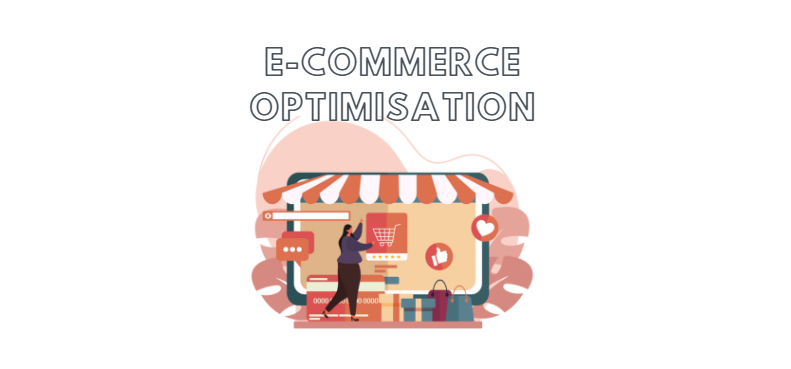In today’s digital marketplace, effective optimisation is no longer an option but a necessity for any e-commerce business seeking to thrive and outpace competition. It pertains to methods and techniques used to enhance the elements of an online store, ranging from website design and navigation to content marketing and search engine optimisation. The goal is to improve the site’s visibility, usability, and conversion rate, leading ultimately to increased sales and customer satisfaction.
Starting with website design, a visually appealing, easy to navigate and user-friendly site lays the foundation for a successful e-commerce operation. Better designed sites tends to attract and retain more customers, thereby increasing the potential for converting visitors into buyers. An integral part of this process is optimising site navigation, which directly impacts the user experience. When customers can easily find what they’re looking for, they’re more likely to make a purchase and less likely to abandon their carts.
Product descriptions and imagery also play a vital role. Descriptions should be informative and enticing, while images should be high-quality and accurately represent the products. Other essential components include implementing responsive design for mobile users, using social proof to boost credibility and conversion, cross-selling and upselling, and employing effective call-to-action strategies.
The Importance of Website Design in E-commerce
The digital age has heightened the importance of deliberate aesthetic appeal, sophisticated architecture, and smooth navigation in the field of e-commerce. At its core, website design integrates both the visual aspects and the practical functionality necessary for an effective online platform. It can wield significant influence over visitor’s first impressions, engagement, and long-term brand loyalty.
Initially, the visual aesthetics of a website is paramount in capturing the immediate attention of potential customers; a well-designed, professional look breeds credibility and trust towards the brand and its offerings. Moreover, the website layout should guide the customer seamlessly from browsing to purchase. This includes clear categorisation of products, intuitive site navigation, quality images, detailed product descriptions, and an efficient checkout process. Ultimately, a well-crafted website design can enhance the user experience leading to increased customer retention, boosted sales, and the overall success of an e-commerce business.
Optimising Site Navigation for User Experience
Facilitating a smooth navigation experience on an e-commerce website is critical for customer satisfaction and consequent conversion rates. A well-structured user interface and intuitive site architecture can significantly boost the user experience, encouraging customers to not only make a single purchase but return for more in the future. The simplification of the browsing process, from product discovery to check-out, forms the backbone of a successful e-commerce platform.
At its core, optimising site navigation involves structuring your website to ensure visitors can find what they are looking for with minimal effort.
1. Leveraging Product Descriptions for Conversion
Product descriptions play a crucial role in e-commerce conversion rates. These carefully crafted texts not only inform potential buyers about the features and benefits of a product, they also persuade customers to complete purchases. The right product description can differentiate a product from its competitors, address consumer hesitations, and highlight key selling points. In essence, it’s the sales pitch of the online retail world.
At its core, the practice of leveraging product descriptions for conversions requires integrating relevant keywords, constructing compelling narratives, and addressing consumer concerns. It begins with a thorough understanding of the product and target audience. Crucial to this is the integration of relevant keywords throughout the product description for optimal Search Engine Optimisation (SEO). Also imperative is the creation of compelling narratives around the product to enhance its value and appeal. Meanwhile, addressing potential consumer concerns proactively can mitigate customer hesitation and instill confidence in their purchasing decision. Hence, each description should be a strategic blend of information, persuasion, and assurance.


- The sales copy clearly communicates the value and benefits of the product.
- It utilizes persuasive language that appeals to customers’ emotions, desires, and pain points.
2. Strategies to Enhance Product Imagery
Enhancing product imagery constitutes a crucial element in the ‘attract-and-entice’ strategy for an ecommerce platform. High-quality images with multiple angles significantly influence customers’ buying decisions and reduce the hesitations that may come with online shopping due to an absence of physical examination of products. A well-executed product imagery strategy not only enriches the visual experience for shoppers, providing a more realistic view of the products, but also improves customer trust, ultimately leading to increased conversion rates.

The enhancement of product imagery begins with choosing high-resolution images that highlight the details of the product. Clear, zoomable images allow customers to inspect the items closely as they would do in a physical store, effectively bridging the gap in the online shopping experience. Furthermore, inclusion of product images in various contexts can give customers a better understanding of its application or usage, invoking a stronger connection with the product. Another effective strategy is the use of 360-degree images or videos that display the product from all angles thereby providing a comprehensive virtual glimpse of the product. Also, ensuring consistency of images in terms of style, size, and presentation across the platform promotes a professional and uniform appearance, which significantly enhances the overall shopping experience.
However, while high-quality product imagery serves to enhance user experience, it is essential to strike a balance so as not to compromise the website’s load speed as this could deter potential customers.
3. Improving E-commerce Site Speed for Better Performance
Site speed plays a significant role in the realm of e-commerce, an aspect that is, unfortunately, often overlooked. It reaches far beyond the mere convenience of quickly loaded web pages; it greatly impacts the user experience, their engagement, and conversion rates, thereby contributing significantly to the success of an online business model.
The mechanics of improving site speed can be multifaceted and technical. Firstly, enabling browser caching can significantly increase site speed as it allows the storage of website data in the user’s browser, reducing the need to send the same data when the user accesses the website subsequently. Additionally, optimising images by compressing them or using suitable formats such as JPEG 2000, JPEG XR, can also significantly boost site speed. Furthermore, businesses could also consider implementing Accelerated Mobile Pages (AMP) to enhance the loading speed of their websites on mobile devices. Reducing redirects, minimising server response time, and using a content distribution network are other effective strategies to enhance site speed.
4. Implementing Responsive Design for Mobile Users
In the realm of E-commerce optimisation, keeping pace with consumer behavior and technological advancements is paramount for success. Given the increasingly mobile-driven consumer market, responsive design has emerged as a critical component in the E-commerce spectrum.
Initially, responsive design entails the strategic structuring of a website’s layout, images, and functionalities to automatically align with the user’s screen size, orientation, and platform. This eliminates the need for separate designs for each device, ensuring consistency of the website’s look and feel, no matter the accessing device. A mobile-friendly website is simple to navigate with suitably sized features for finger-tip access, readable text without zooming, and avoidance of unplayable content. Subsequently, the implementation process involves key stages such as planning and wireframing, designing and developing, testing and launching.

A defining feature is the fluid grid layout that accommodates any screen size, wherein elements resize in relation to one another, thereby maintaining design integrity. Such meticulous attention to detail on the accessibility front can significantly enhance the user experience, consequently driving higher conversion rates.
5. Effective Call-to-Action Strategies for E-commerce Sites
In the bustling world of e-commerce, an effective call-to-action (CTA) can be the driving force behind customer conversion and website profits. It serves as a signpost that guides potential consumers down the path to purchase, directing their attention to desirable actions like ‘Buy Now’, ‘Sign Up’, or ‘Learn More’. Largely instrumental in dictating the user’s journey, a well-strategised CTA can boost conversions, improve user engagement, and ultimately, result in increased revenue streams for online businesses.
In the realm of e-commerce, crafting a compelling CTA involves a blend of creativity, strategic placement, and repetitive testing. At its most basic, your call-to-action should be immediately noticeable, ideally positioned in a prime spot where viewers’ eyes naturally gravitate. An effective CTA should be encapsulated by striking button or hyperlink, standing out through the use of contrasting colors, bold typography, and attractive design elements. Beyond aesthetics, CTAs must incorporate compelling, action-driven language that incites urgency and taps into the viewers’ fear of missing out.

Regular A/B testing is essential to determine the effectiveness of different CTA elements and tweak them for optimal conversion rates. From color and position to wording and size, each detail of your CTA can make a substantial difference in the overall user experience and the success of your e-commerce venture.
6. The Role of Social Proof in E-commerce Conversion
Social proof acts as an exceptionally powerful tool within the realm of e-commerce, effectively transforming potential prospects into committed customers. Originating from the field of psychology, social proof leverages the inherent human tendency to replicate the actions and decisions of others, assuming such behavior as an indication of correct conduct. In essence, when consumers observe numerous individuals purchasing or endorsing a product, they are compelled to follow suit, perceiving the product as trustworthy and reliable.
Incorporating elements of social proof into e-commerce platforms not only bolsters conversion rates but also strengthens the overall credibility of the brand. Customer testimonials, user reviews, celebrity endorsements, and social media shares all constitute prominent examples of social proof. The display of large numbers of product sales also serves as a form of social proof.

Through the strategic implementation of these components, businesses can influence purchasing decisions, enhance customer trust, and ultimately, augment sales. Furthermore, integration of real-time purchaser notifications, certifications and trust badges contribute significantly to the establishment of social proof, adding an additional layer of consumer confidence and satisfaction.
7. The Impact of Customer Reviews on Purchase Decisions
Customer reviews have emerged as a crucial factor influencing purchase decisions. This trend is mainly driven by the changing consumer behavior in the digital era, where shoppers heavily rely on peer reviews and experiences to inform their purchasing decisions.
Online customer reviews offer insights into the product’s quality, usability, and overall satisfaction from the previous buyer’s perspective. Positive reviews can instill a sense of trust, authenticity, and reliability about the product, increasing its attractiveness to potential buyers. On the other hand, negative reviews can act as a deterrent, prompting potential buyers to search for better alternatives. Therefore, effectively managing customer reviews, both positive and negative, can substantially impact an e-commerce business’s conversion rates and overall success.
8. Importance of Secure Payment Gateways in E-commerce
Stepping into the almost limitless world of e-commerce can appear daunting, especially when it comes to establishing customer trust. More specifically, ensuring the security of payment transactions stands as a paramount concern. This significance stems from the sensitivity of customers’ personal and financial data, as well as the possible ramifications of mismanagement or data breaches. Thus, secured payment gateways act as the linchpins in fostering and retaining customer trust and contributing significantly to the overall customer experience.
Delving into the realm of secured payment gateways, the sophisticated system functions to encrypt and protect the customer’s payment information during the transaction process. This encrypted transaction data is securely transmitted between the customer, merchant, and payment processor, shielding it from prying eyes and attempts of unauthorised access. The implementation of such technology not only elevates the commercial entity’s status in the market but also enhances customer loyalty and return rates. It creates a sense of security, assuring customers that their sensitive information is well-protected, heightening their willingness to conduct transactions. In a nutshell, secure payment gateways form the bedrock of seamless, secure, and trust-based digital commerce.
The Art of Cross-Selling and Upselling
Cross-selling and upselling strategies have become indispensable tools in the palette of any e-commerce retailer seeking to boost customer engagement, retention, and ultimately, sales figures. Cross-selling involves recommending related or complementary items to the product a customer is viewing or has already selected to purchase. Conversely, upselling encourages customers to buy a higher-end product or add-on to increase the sale’s value. Both these strategies, when expertly applied, can subtly lead customers to perceive additional value in their purchase, enhancing their overall shopping experience and fostering customer loyalty.
CROSS-SELLING
UPSELLING


In order to properly grasp the complexity of cross-selling and upselling, one must first understand the delicate nature of online consumer behavior. Internet buyers are notorious for their fleeting attention spans and impatience towards overly aggressive sales tactics. Therefore, it is critical to integrate cross-selling and upselling techniques seamlessly into the user experience. When suggesting additional or higher-value products, retailers must ensure relatedness, relevance, and clear value. Introducing these suggestions in a non-invasive manner, such as subtle prompts during the checkout process or personalising recommendations based on a consumer’s browsing history, has proven to be highly effective.
Maximising Conversion with Personalisation Techniques
Personalisation can significantly boost conversion rates by providing customers with a unique and tailored shopping experience that suits their preferences and aims to fulfill their specific needs. It elevates the standard of serving every customer identically through traditional marketing approaches, and instead recognises each customer as an individual with unique characteristics and buying behaviors. In this age of e-commerce, personalisation techniques are not just an option, they are a necessity. They have the potential to completely transform the way businesses interact with their consumers and turn casual browsers into loyal customers.
Personalisation begins with the collection and analysis of user data. It’s about understanding each customer’s behavior, preferences, and purchasing history. Using this valuable information, businesses can design targeted marketing campaigns, offers, and recommendations that perfectly fit each customer’s needs. For instance, product recommendations can be based on previously viewed or purchased items, ensuring that the items highlighted truly resonate with the customer. Likewise, the display of personalised content, such as specific offers, deals or discounts based on customer’s past shopping experience, can enhance user engagement and encourage impulsive buying decisions. Email marketing can also be markedly improved through personalisation by addressing customers by their first name or offering items carefully chosen based on their previous purchases. Employing personalisation techniques not only improves the user experience but also helps businesses understand their customers at a much deeper level, resulting in strengthened relationships and ultimately driving a higher conversion rate.
Leveraging Email Marketing for E-commerce Conversion
Email marketing remains one of the most trusted and effective digital marketing strategies within e-commerce space. It serves as a critical tool for both driving new sales and nurturing existing customer relationships. A well-structured, optimised email strategy can boost conversion rates, increase customer loyalty, and significantly impact your business’s bottom line.
Utilising Search Engine Optimisation for E-commerce

Search Engine Optimisation (SEO) serves as an integral tool in the arsenal of effective e-commerce strategies. When properly executed, it holds the potential to significantly amplify the visibility of an e-commerce site, attract high-quality traffic, and, in turn, increase the likelihood of conversion. However, the complex nature of SEO often poses a daunting challenge to many e-commerce stakeholders, hence it is essential to understand its scope and significance.
The interplay of SEO in e-commerce begins with keyword research, a systematic investigation to identify common search terms prospective customers use to find certain products or services. Implementing these keywords judiciously in website content can dramatically enhance a site’s ranking on search engine results pages (SERPs), subsequently driving more traffic. Additionally, on-page SEO—encompassing product descriptions, meta descriptions, title tags, URLs, and images—plays a pivotal role in making webpages more appealing to search engines. Optimising site speed and mobile compatibility also contribute to better SEO as search engines value sites that offer a superior user experience. Off-page SEO, involving techniques such as backlinking and social media marketing, further enhances a site’s reputation and credibility. Overall, by enhancing the visibility and attractiveness of an e-commerce site, SEO becomes an invaluable tool in propelling its success.
Harnessing the Power of Content Marketing in E-commerce
Exponentially rising competition in the digital marketplace necessitates the need for e-commerce businesses to adopt a multitude of strategies for customer attraction and retention. One crucial tool is content marketing, capable of fascinating prospects, alongside providing substantiated value which leads to a sustained customer engagement. For an e-commerce platform, content marketing strategically aligns its products with competent, valuable and captivating information to aid prospects in their decision-making processes. It is a comprehensive practice that extends beyond basic product descriptions, encompassing blogs, articles, videos, infographics, podcasts, tutorials, and more. This practice is power personified; it fosters brand awareness, shapes the brand’s voice, stimulates user interaction and ultimately, catalyzes conversion.

The initiation of content marketing for e-commerce begins by identifying the target audience, understanding their needs, inquiries, and interests. These insights are then constructively wielded to create engaging, informational resources tailored to answer the queries and satisfy the customers’ expectations. For instance, a business that sells skincare products might develop a blog on ‘the science behind skincare’ or ‘tips for maintaining a healthy skin’. Following content creation, it’s equally imperative to distribute it via platforms where the brand’s target audience ‘hangs out’, hence extending the brand’s reach to potential customers. Subsequently, the impact of posted content can be monitored through user engagement metrics, which will offer insights and highlight areas requiring any refinement or improvement. Content marketing in e-commerce is not a one-size-fits-all approach; it requires careful planning, execution and monitoring. Here are some key steps to harness its power:
- Identifying the Target Audience: The first step involves understanding who your potential customers are. This includes their demographics, interests, pain points and online behaviour.
- Creating Relevant Content: Once you have identified your target audience, develop content that resonates with them. It should be informative, engaging and valuable enough to answer their queries or solve their problems.
- Choosing the Right Platform for Distribution: After creating high-quality content, distribute it on platforms where your target audience spends most of their time online. This could be social media sites like Facebook or Instagram, search engines like Google or Bing, email newsletters or even podcasts.
- Monitoring User Engagement Metrics: Keep track of how well your content is performing by analysing user engagement metrics such as likes, shares and comments on social media posts; click-through rates (CTR) for emails; views and watch time for videos etc.
- Refining Your Strategy Based on Insights: Use these metrics to identify what type of content works best with your audience. If certain topics get more engagement than others do more of those while reducing less popular ones.
Remember that successful content marketing isn’t just about selling products but providing value through information which builds trust among consumers leading to long-term customer loyalty.
Abandoned Cart Recovery Strategies
As digital consumers, we’ve all been there: browsing an online store, adding items to the cart, only to abandon the purchase at the last minute for various reasons. This phenomenon is all too common among online retailers and is a significant issue they grapple with daily. Abandoned carts represent lost revenues, but more importantly, they signify a missed opportunity to effectively engage with potential customers.
To recover these lost opportunities, implementing a strategic recovery approach is essential. The initial step in this approach is to identify the reasons that led to the abandonment. Whether it was due to website navigation difficulties, unexpected shipping costs, or just casual browsing, understanding the customer’s experience allows for a more tailored recovery strategy. Following this, targeted communication tactics such as personalised emails or notifications can be deployed. These should gently remind the customers of their abandoned items and ideally incentivise them with perks like discounts or free shipping to complete the purchase. Additionally, employing tools like exit-intent pop-ups can effectively capture customers at the brink of abandonment, enticing them to stay and finish the transaction. Finally, ensuring a seamless and simple checkout process sustains the customer’s convenience, minimising the likelihood of cart abandonment.
Measuring E-commerce Success with Key Metrics
In the dynamic digital landscape, evaluation of business performance and success has transformed significantly. Advanced digital tools and analytics have provided e-commerce platforms with the ability to measure their effectiveness using a variety of key metrics. These range from website traffic, conversions, bounce rate, customer acquisition costs, average order value, to cart abandonment rates and more. The judicious interpretation and analysis of these key performance indicators (KPIs) offer valuable insights into business health and areas that need optimisation for improved performance.
Undeniably, one of the essential parameters to consider is website traffic; they represent the number of potential customers reaching your online storefront. However, the number of visitors is of limited value if conversions remain low. Conversion rate, calculated as the ratio of visitors who make a purchase to total site visitors, shines a light on the efficiency of the store in turning potential customers into buyers. Meanwhile, other metrics like bounce rates highlight issues in user engagement and site functionality. Average order value (AOV) indicates the average amount spent by customers per transaction, a critical figure defining profit margins. Additionally, understanding customer acquisition costs can help businesses adjust their marketing strategies for cost-effective growth. Metrics like cart abandonment rate pinpoint user experience flaws that might deter customers from making a purchase. In essence, these various metrics work together, forming a comprehensive view of an e-commerce business’s performance and illuminating pathways to success.
Implementing Live Chat for Improved Customer Service

In the competitive landscape of e-commerce, customer service can be the differential that sets a brand apart. One such service that has gained considerable traction in recent years is the implementation of live chat. This highly interactive and customer-centric tool can be a game changer for e-commerce businesses, providing real-time support and assistance to customers. Live chat offers an immediate communication channel to solve customer queries, enhance the shopping experience, and ultimately, improve customer satisfaction and loyalty.
This tool creates an opportunity for e-commerce sites to engage with customers in real-time. When a customer lands on the website, they may have doubts or questions about a product or service. Instead of them searching for information on the website or having to wait on a customer hotline, they can instantly get help from a live chat representative. Not only does this increase customer satisfaction, it also increases the chances of conversion, as doubts are clarified promptly and a reassuring human connection is made. Furthermore, modern live chat tools are equipped with features such as chat transcripts and analytics, giving businesses valuable intel about customer behavior, common questions and potential roadblocks in the purchase journey. This data can be leveraged to enhance website designs, improve product descriptions, and tailor customer service strategies.
Continuous Improvement: The Role of A/B Testing in E-commerce Optimisation.
In the vibrant landscape of e-commerce, the process of continuous improvement is crucial, and A/B testing plays an instrumental role in this ongoing quest for optimisation. A/B testing, also known as split testing, facilitates making crucial decisions driven by data. It’s a comparative analysis methodology in which two versions of a webpage or other user experience elements are evaluated against each other to ascertain which performs better. Through this method, businesses can test the effect of diverse changes on their website, such as product descriptions, images, or call-to-action buttons, and determine which versions generate better results.

